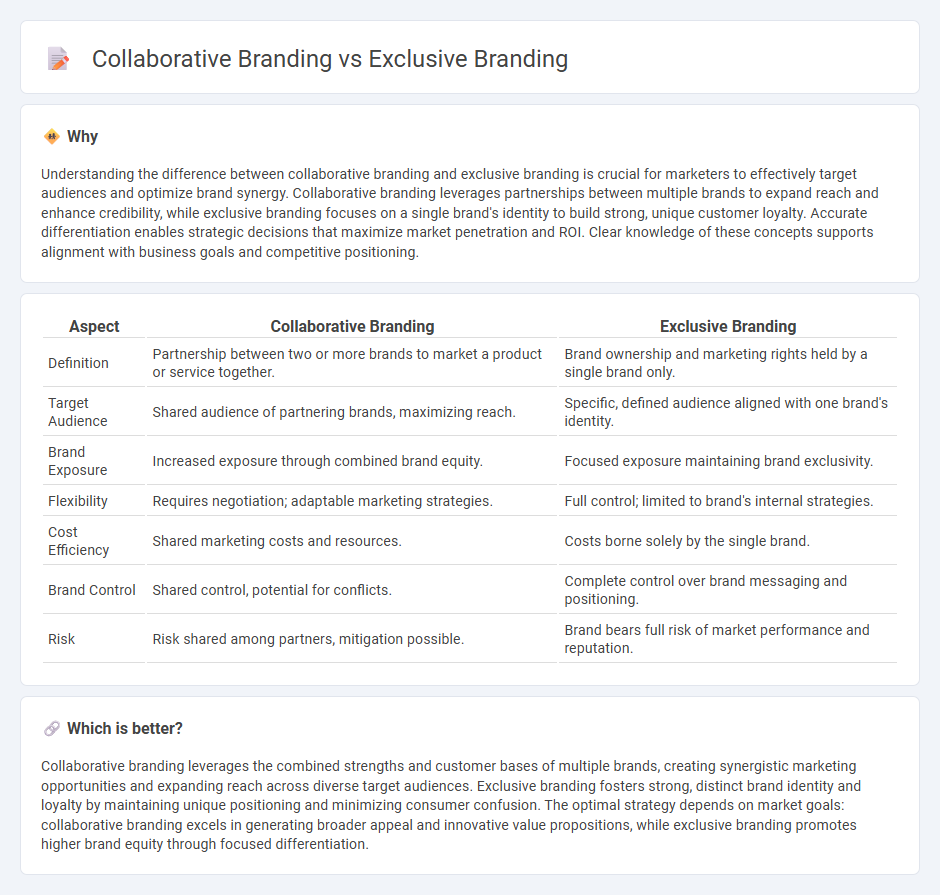
Collaborative branding combines the strengths of multiple brands to create a unique market presence and expand customer reach, leveraging shared resources and co-created value. Exclusive branding focuses on developing a distinct and proprietary identity, emphasizing uniqueness and premium positioning to build customer loyalty and higher perceived value. Explore the strategic advantages of both approaches to optimize your marketing impact.
Why it is important
Understanding the difference between collaborative branding and exclusive branding is crucial for marketers to effectively target audiences and optimize brand synergy. Collaborative branding leverages partnerships between multiple brands to expand reach and enhance credibility, while exclusive branding focuses on a single brand's identity to build strong, unique customer loyalty. Accurate differentiation enables strategic decisions that maximize market penetration and ROI. Clear knowledge of these concepts supports alignment with business goals and competitive positioning.
Comparison Table
| Aspect | Collaborative Branding | Exclusive Branding |
|---|---|---|
| Definition | Partnership between two or more brands to market a product or service together. | Brand ownership and marketing rights held by a single brand only. |
| Target Audience | Shared audience of partnering brands, maximizing reach. | Specific, defined audience aligned with one brand's identity. |
| Brand Exposure | Increased exposure through combined brand equity. | Focused exposure maintaining brand exclusivity. |
| Flexibility | Requires negotiation; adaptable marketing strategies. | Full control; limited to brand's internal strategies. |
| Cost Efficiency | Shared marketing costs and resources. | Costs borne solely by the single brand. |
| Brand Control | Shared control, potential for conflicts. | Complete control over brand messaging and positioning. |
| Risk | Risk shared among partners, mitigation possible. | Brand bears full risk of market performance and reputation. |
Which is better?
Collaborative branding leverages the combined strengths and customer bases of multiple brands, creating synergistic marketing opportunities and expanding reach across diverse target audiences. Exclusive branding fosters strong, distinct brand identity and loyalty by maintaining unique positioning and minimizing consumer confusion. The optimal strategy depends on market goals: collaborative branding excels in generating broader appeal and innovative value propositions, while exclusive branding promotes higher brand equity through focused differentiation.
Connection
Collaborative branding leverages the combined strengths of two or more brands to create a unique product or campaign that enhances market reach and brand equity for each partner. Exclusive branding focuses on creating a distinct identity or product line that differentiates a brand from competitors, often through limited availability or unique features. When combined, collaborative branding can incorporate exclusive branding elements to generate buzz and exclusivity, driving consumer interest and increasing perceived value.
Key Terms
Brand Ownership
Exclusive branding ensures full brand ownership by a single company, allowing complete control over marketing, product development, and customer experience. Collaborative branding shares brand ownership among multiple partners, leveraging combined resources and expertise but requiring aligned goals and mutual brand management. Explore how these strategies impact brand equity and market positioning for informed decision-making.
Strategic Partnerships
Exclusive branding creates a controlled, singular brand identity that enhances customer loyalty and strengthens market positioning by limiting partnerships to select entities. Collaborative branding leverages multiple brands' strengths through strategic partnerships, expanding reach and fostering innovation to create shared value. Explore the advantages and strategies behind exclusive and collaborative branding to optimize your business partnerships.
Co-Branding
Co-branding involves two or more companies partnering to create a product that leverages the strengths, reputations, and customer bases of each brand, leading to enhanced market reach and shared marketing efforts. Exclusive branding focuses on a single brand's identity and control over product design, messaging, and customer experience, which can strengthen brand loyalty but limits cross-brand exposure. Explore the strategic advantages of co-branding to maximize brand synergy and consumer appeal.
Source and External Links
Build An Exclusive Brand Without Actually Excluding Anybody - Create a luxury brand identity with a strong logo, tagline, and premium customer service experiences for all shoppers, ensuring exclusivity feels inclusive rather than exclusionary.
Luxury Branding Strategy - 7 Steps to Market Dominance - Emphasize exclusivity, premium quality, and a distinct brand identity while using tactics like limited inventory and influencer partnerships to make customers feel part of an exclusive community.
The Rise of Quiet Luxury: Branding in 2025 - Focus on curated, limited product offerings and discreet distribution channels (e.g., direct-to-consumer, private appointments, boutique partnerships) to amplify a sense of rarity and exclusivity without overt branding.
 dowidth.com
dowidth.com